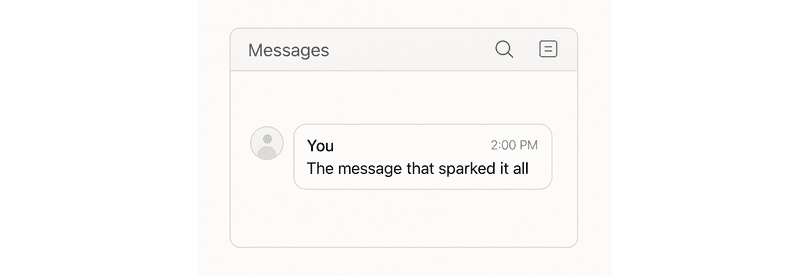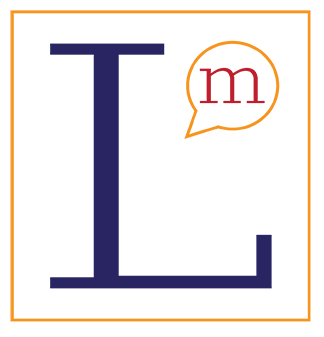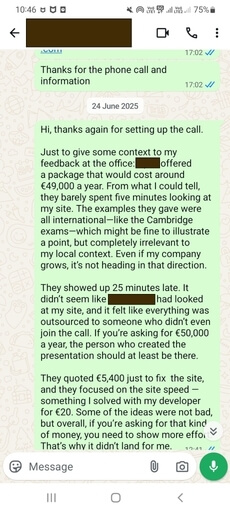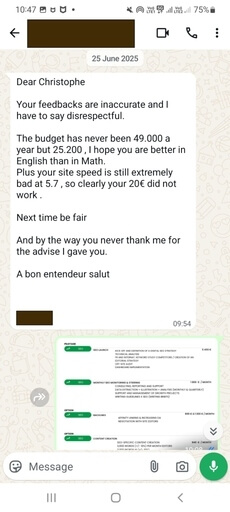When Language Sparks Conflict: A revealing case study in digital communication etiquette and emotion
How digital communication can burn bridges — Online and off
Let’s start with a real message. This was sent to me after I gave candid feedback about a third-party provider who had been recommended to me:

The message that sparked it all
Dear Christophe
Your feedbacks are inaccurate and I have to say disrespectful.
The budget has never been 49.000 a year but 25.200 , I hope you are better in English than in Math.
Plus your site speed is still extremely bad at 5.7 , so clearly your 20€ did not work.
Next time be fair.
And by the way you never thank me for the advise I gave you.
À bon entendeur salut,
P….
This wasn’t just a misjudged reply. It was a case study of how digital language—when unmanaged, emotionally loaded, and linguistically careless—can collapse not one but several professional bridges.
It also highlights how essential digital etiquette is in today’s professional and digital landscape—especially in digital interactions when tone, context, and emotional nuance must be conveyed without nonverbal cues.

What just happened? Digital Communication etiquette gone wrong.
This was a reaction to my honest opinion about a call with a Digital Marketing company I had been advised to consider.
The meeting didn’t go well: late arrival, perceived lack of preparation, as well as an expensive proposal and audit that didn’t align with our needs.
I shared this feedback, plainly and respectfully with the person who had recommended them after they asked about the meeting.
But judge for yourself – Here’s the original message with names removed.
I might have sugar-coated it a bit if it was directly to the provider, but this was a third party, and this should hurt no emotions.
When feedback goes public
Then came the email above—defensive, sarcastic, and oddly personal. What made it worse was that the sender wasn’t even officially affiliated with the company he was defending, yet he revealed that details from the private meeting had been shared with him.
The cost of oversharing
That did two things:
- It made it clear that confidential feedback had been passed on—without consent.
- It burned not only our direct working relationship, but also any chance of collaboration with the third-party company he was trying to protect.
All of it over WhatsApp.

A deeper concern: Trust and confidentiality
The communication also raised deeper concerns:
The number mentioned (€25,000) was off—but the fact that any number was mentioned suggests something more troubling. Two possibilities emerge:
- Most likely: the person I was corresponding with shared my private feedback with a third-party provider (one they had recommended), who then gave them details from our private call—without my knowledge.
- Alternatively: he fabricated the figure entirely to make a rhetorical point.
Either scenario is problematic.
The first points to a breach of confidentiality. What should have been a private exchange between a potential client and service provider was apparently turned into a backchannel conversation between others.
Neither version leaves room for trust. And in an industry where both individuals deal with sensitive internal information about businesses, this kind of disclosure is a red flag.
It may not seem dramatic at first glance. But in practice, it means I—and likely others—can no longer speak freely with either party. And considering this person has actively recommended the provider to others, it raises reputational and ethical concerns well beyond tone and etiquette.
Backchannel chat is a reality. While companies do their best to limit the leak of confidential information, this cannot be always assured.
People speak to each other in professional and non-professional capacities, and private information can easily be disclosed… even if the person promises very firmly not to do so…
But what’s particularly concerning here is the casual, even boastful, way the breach was presented.
Rather than showing discretion, it was offered as proof in an argument. That turns a typical lapse into a public liability.

Digital etiquette: Where did the message go wrong?
When communicating digitally, every word must be chosen with intention.
Let’s break it down.
- “I hope you are better in English than in Math.”
? A sarcastic jab. Meant to correct, but it humiliates. It escalates a minor factual disagreement into a personal attack.
- “Your feedbacks are inaccurate and I have to say disrespectful.”
? Vague labelling. No attempt at clarification or dialogue. It shuts the door before it’s even opened.
- “You never thank me.”
? A personal grievance disguised as professional commentary. Passive-aggressive, and off-topic.
- “À bon entendeur salut.”
? The digital equivalent (in French) of slamming a door in someone’s face. Final. Irreparable.
- Spelling errors, Lack of proper grammar, and the misspelled recipient’s name.
? Ironically undermines the authority of someone who is critiquing linguistic accuracy.
As Steven Pinker would say, language isn’t just a tool for sharing facts—it’s a tool for negotiating social relationships. In this case, it was a blunt instrument wielded in a glasshouse.

The invisible risk of virtual communication
In face-to-face interaction, a tone can soften a critique. A raised eyebrow, a pause, or even a smile can repair a moment of tension.
But digital messages? They’re frozen in time.
No facial expression. No vocal tone. No undo button.
Unlike in the physical world, where you can adjust your delivery in real-time, digital words are permanent and context-free.
More dangerously, they can be:
- Forwarded.
- Screenshotted.
- Shared out of context.
- Used to assess your character long after the exchange.
This risk is amplified when your profession revolves around branding, communication, and reputation—as was the case here.
The sender is a marketing consultant, someone who helps others shape their image and manage how they’re perceived.
In this particular case, the damage is minor. It’s been shared only as a learning moment, with no names and no identifying details.
In today’s digital world, with instant messaging and one-click sharing, a multitude of digital channels, a single message doesn’t just stay between two people.
An increasing number of digital channels means it can appear on social media, in internal company chat platforms, WhatsApp groups, or industry forums—sometimes with names, screenshots, and context included.
Now imagine a different context:
- A customer support agent replying to a complaint
- A company spokesperson responding to a public concern
- A business development lead communicating with a potential client
In those cases, one emotional message—seen by the wrong person—can do far more than ruffle feathers. It can undermine credibility, harm trust, and do more damage to a reputation than a failed pitch ever could.
What could have been written instead? Appropriate language & concise language
Avoid sarcasm, use neutral language, and prioritize clarity over cleverness.
Let’s imagine this message had been written with emotional intelligence and linguistic strategy:
Message version 2.0 – retain relevant details while remaining respectful.
Hi Christopher,
I wanted to clarify a few points from your feedback.
From my understanding, the budget proposal was closer to €25,200 than €49,000—perhaps there was a miscommunication there. If you’d like to share the quote with me, I’d be happy to take another look.
Regarding site speed, while I see improvements, there are still some performance issues. It might be worth exploring what’s affecting those scores.
Finally, I hope my suggestions during the call were useful. Even if our perspectives differ, I shared them in the spirit of collaboration.
P….
This version is still corrective. But it’s constructive. It defends key points without sounding defensive.
It presents the disagreement in a positive light, allowing both sides to maintain their dignity and remain open.
And crucially, it keeps the bridge intact.
Alternatively
Message version 2.1 – Polite, concise, and conflict-avoidant
Hi Christophe,
Sorry to hear it didn’t work out. From my experience, they’ve been appreciated by our clients, but well, not every fit is perfect.
P….
This version is concise. It avoids confrontation and doesn’t waste time. It acknowledges the communication, and that’s about it. It stands behind the company but does not try to change my mind.
And most importantly, it leaves the door open and the bridge intact.
The real lesson: Language is strategy – Guided by objectives
Learning a language or to communicate is much more than verb conjugation or vocabulary. Language is a strategic tool, especially in virtual and multilingual environments where every word carries weight.
Balanced wording and phrasing can help you:
- De-escalate tension with the right phrasing
- Deliver hard feedback without creating hard feelings
- Choose tone, format, and structure that protect your relationships, even when your message is tough
In virtual communication, fluency is more than just words. It’s judgment, timing, and emotional precision.
Whether you’re replying to a client, preparing a quarterly presentation, addressing a room full of stakeholders, or navigating a delicate situation, your words matter.
And in non-verbal contexts, the choice and weight of those words become even more critical.
Always communicate with the objective in mind.
Written language gives us a luxury that spoken language doesn’t always offer: time to reflect.
Yet many people don’t use that time. They respond emotionally, defensively, or impulsively—without considering the long-term objective of their message.
The email discussed in this article had one apparent aim: to defend the sender and belittle the recipient.
But here’s the problem: this was a professional relationship. It’s hard to believe the sender’s real intention was to destroy it entirely.
Even if the working relationship was over, the professional world remains small. People talk. A reputation can travel faster than a contract ever will.
If the true goal was to inflict reputational damage, then perhaps the message succeeded. But it’s unlikely that was the conscious objective.
Think and take time before hitting send – A better goal might have been:
- “Let’s defend the company while leaving the door open.”
- “Let’s express concern and professionalism.”
- “Let’s respond in a way that won’t be used against us later.”
If the objective had been defined clearly—protect the relationship, the brand, and the future—then the wording would have looked very different.
Understanding cultural differences is also an important aspect of maintaining positive relationships. Especially when body language is missing.
Adding a personal touch to an email can make a positive difference. However, it’s essential to recognize that a lack of tone can distinguish between light banter and offensive content.
That’s what we teach at My Linguistics: how to write with strategy, not just fluency.
Final thought – Double check, relax, and think of long-term objectives before sending
The message I received could have opened the door to dialogue. Instead, it served as a warning.
So, what was the goal? In most professional environments—especially in consulting or client-facing roles—the goal is to maintain the relationship, even when disagreements happen.
You don’t have to agree. You don’t even have to work together again. However, keeping the door open is usually a good business practice.
If the goal of that message was truly to sever ties or cause reputational damage, then it may have achieved that. But I doubt that was the intention. More likely, it was an emotional reaction, sent without strategic thought.
And that’s the point.
Whether you’re working with global or local teams, in international markets, within any digital-first environment, or even in an artisanal boutique workshop, understanding the importance of your written communication isn’t optional. It’s your professional shield—and sometimes, your only defense.
Anyone can learn to speak a language. But communicating with care, strategy, and credibility—that’s where the real fluency begins.
Want to sharpen your communication in English or French?
From concise subject lines to complex written negotiations, every word you choose can shape a professional relationship.
We offer private and group courses focused on high-level, real-world communication.
Not just grammar. Not just vocabulary. But language that builds trust, even when the conversation gets tough.
Contact us to learn more.





